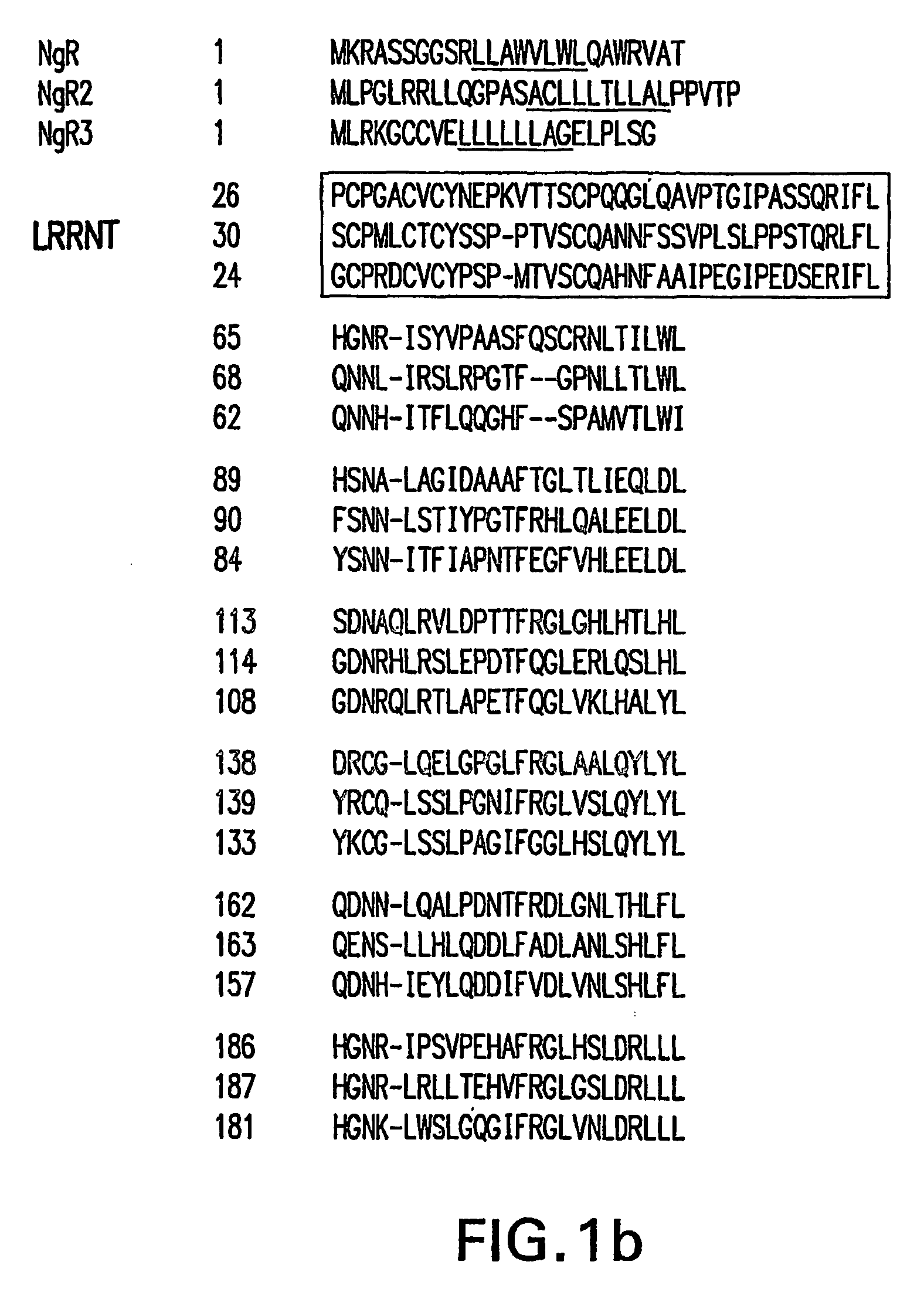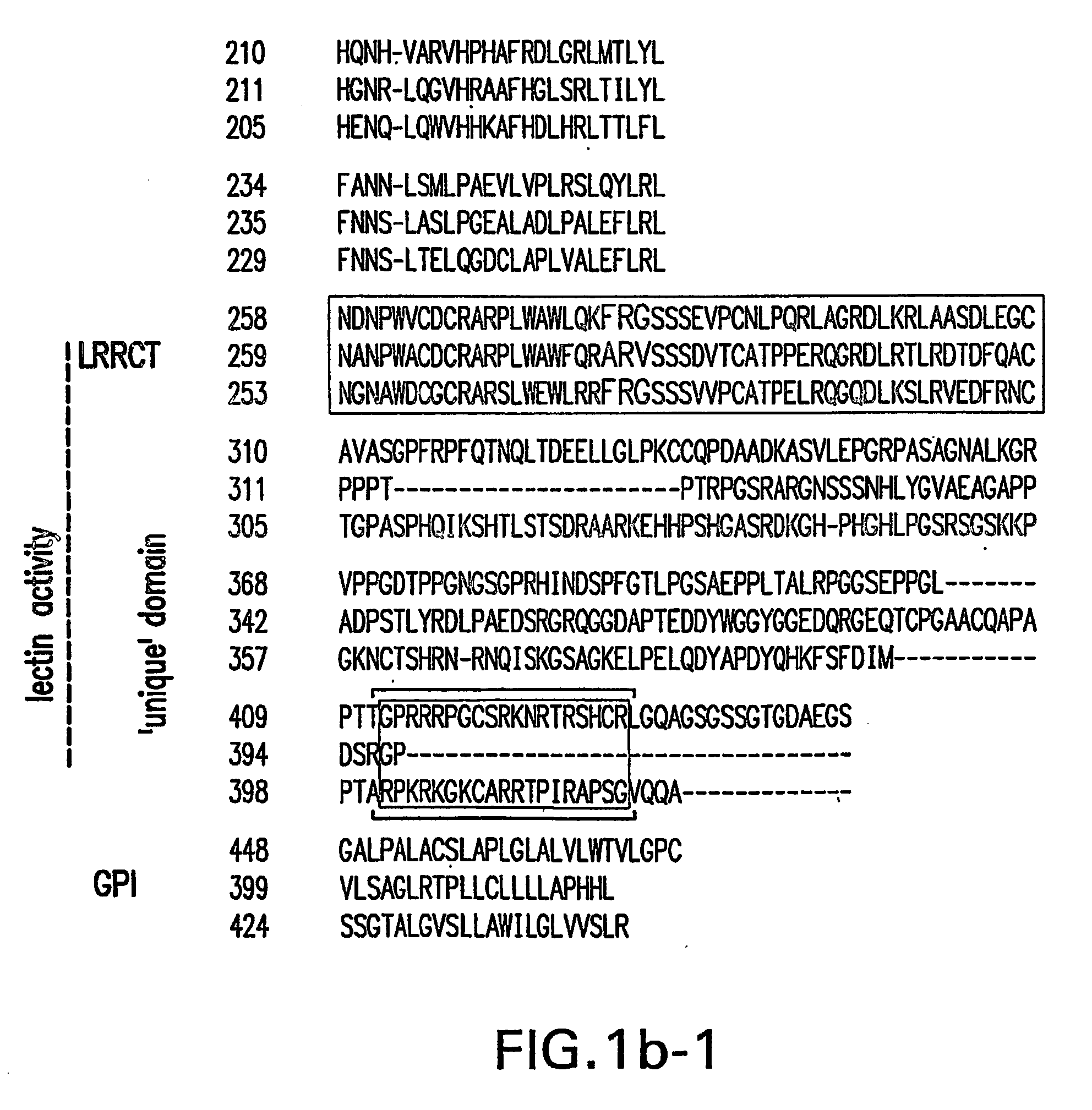Identification of novel nogo-receptors and methods related thereto
a nogoreceptor and novel technology, applied in the field of identification of novel nogoreceptors and methods related thereto, can solve the problems of spinal cord injury treatment (sci) and inability of damaged axons to regenerate in the mammalian central nervous system (cns)
- Summary
- Abstract
- Description
- Claims
- Application Information
AI Technical Summary
Problems solved by technology
Method used
Image
Examples
example 1
1. Example 1
Identification of the Nogo Receptor Gene Family
[0221] NgR2 and NgR3, are neuronal glycoproteins that share an overall domain organization identical to NgR. Toward their amino end, Nogo-receptors (NgRs) harbor a tandem array of eight leucine-rich repeats (LRRs). Embedded in the C-terminal portion of NgR and NgR3, but not NgR2 is a lectin activity. In the mature nervous system, nogo receptors are preferentially expressed in neurons and show highly similar distribution patterns. NgRs show distinct but partially overlapping binding preferences toward different myelin-associated growth inhibitors. NgRs are GPI-linked molecules, exist in a membrane-bound and soluble form, and are enriched in lipid rafts in brain. Soluble NgR and NgR3 bind with high affinity to major central nervous system fiber tracts, including the optic nerve and dorsal corticospinal tract. Binding to brain is mediated by the NgR and NgR3 lectin activity and is sensitive to neuraminidase and heparinase III ...
example 2
2. Example 2
a) NgR2 Gain-of-Function Studies:
[0276] In a series of experiments, whether ectopic expression of NgR2 can be sufficient to induce MAG responsiveness in cultured E7 chick DRG neurons is addressed. E7 chick DRG neurons are unresponsive to MAG and do not express NgR (Liu et al., 2002). Western blot analysis with anti-NgR2 IgG revealed no NgR2 expression at E7 and moderate expression at E13. HSV-mediated expression of NgR in E7 chick DRG neurons confers MAG responsiveness (Liu et al., 2002).
[0277] Using a very similar approach, NgR2 can be expressed in chick E7 DRG neurons and MAG responsiveness can be quantitatively assessed in a ‘growth cone collapse’ assay (for details see below). For ectopic expression studies of Nogo receptor family members in primary neurons, herpes simplex (HSV) mediated gene transfer can be employed. HSV vectors can harbor a bi-cistronic expression cassette carrying the gene of interest and simultaneously express green fluorescence protein [GFP] (...
example 3
3. Example 3
a) Co-Localization of Nogo Receptor Family Members in Neurons:
[0290] Double in situ hybridization can be performed to establish NgR and NgR2 / NgR3 co-expression. This can reveal how these receptors function in various cell populations. The studies presented herein show that cRNA probes for NgR, NgR2, and NgR3 were specific and did not cross-react with other family members. Furthermore, in the CNS NgR, NgR2, and NgR3 are broadly expressed in projection neurons and staining patterns are largely overlapping (e.g. FIG. 3). Specifically, double-fluorescence in situ hybridization technique, featuring digoxigenin (DIG)- and biotin-labeled riboprobes specific for NgR and NgR2, can be used and in a parallel approach probes for NgR and NgR3 can be used. Cryosections of embryonic, postnatal, and adult rat brain and spinal cord can be hybridized with DIG-labeled NgR cRNA probe and biotin-labeled NgR2 (or NgR3) cRNA probe. Two different fluorescence signals (fluorescein isothiocyanat...
PUM
| Property | Measurement | Unit |
|---|---|---|
| Fraction | aaaaa | aaaaa |
| Solubility (mass) | aaaaa | aaaaa |
| Disorder | aaaaa | aaaaa |
Abstract
Description
Claims
Application Information
 Login to View More
Login to View More - R&D
- Intellectual Property
- Life Sciences
- Materials
- Tech Scout
- Unparalleled Data Quality
- Higher Quality Content
- 60% Fewer Hallucinations
Browse by: Latest US Patents, China's latest patents, Technical Efficacy Thesaurus, Application Domain, Technology Topic, Popular Technical Reports.
© 2025 PatSnap. All rights reserved.Legal|Privacy policy|Modern Slavery Act Transparency Statement|Sitemap|About US| Contact US: help@patsnap.com



